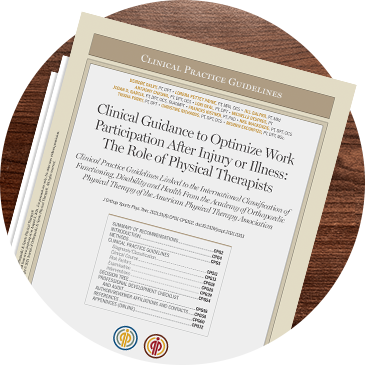It appears that I am in for a long evening. I am preparing to complete a functional capacity evaluation that is on my schedule for tomorrow. Along with this referral came the medical records to review, two reams of paper that were received by our clinic earlier today. I am exhausted already! This case involves a 42-year-old worker that sustained an ankle sprain two years ago. To make this long story short, the worker remains off work and is applying for disability. They continue to participate in physical therapy involving soft tissue mobilization and dry needling.
Upon meeting this individual, I delve further into the history. My questioning goes like this: Have any transitional return-to-work duties been attempted? Has therapy included any job specific activity that replicates the time of injury work? Are you in contact with your case manager? The answer to each of these is… NO. I am discouraged now. This person is needlessly facing a rough road ahead.

The above scenario begs the question, “What is guiding clinical decision-making from initial injury to return to work?” After reading numerous histories like the one described above, a group of physical therapists decided to look at the research to figure out how to best guide practice. Sure enough, we wrote a 102-page novel of our own, known as a clinical practice guideline! Now before I lose you, we have come up with some-bite size pointers that you can implement today, with your next patient that presents with a work restricting injury. You can end this kind of story before it begins.
The first step involves the oh so simple task of… talking with your patient. You can simply ask them about their job, what is difficult about their job, what are the good parts of their job, do they want to return, and are they working now? During this conversation, get a sense of the job’s physical demands and the workplace culture. For more specific information, you should have a short conversation with the employer or the case manager to obtain a job analysis and to determine the availability of restricted/transitional work duty.
During each rehab visit, incorporate specific work activities, progressing the intensity as you would with any other patient. Use their job description to guide inclusion of appropriate activities (such as reaching, lifting, pushing, etc.) in the treatment sessions.
You need to act with urgency. The worker would like to return to normalcy. The employer would like to have a healthy, productive work force. Initiate appropriate care as quickly as possible following injury, ideally within 2 weeks of injury. There is no need to wait for “pain free status” to return to work as work itself can be therapeutic.
Respect the context of their injury. This individual may be experiencing stress with a change in income, a sense of decreased worth as an integral part of the workplace, or confusion related to the compensation process. Validate and be empathetic toward the worker’s emotional processing of this sudden change in work status and ability. Reach out to experts if you recognize psychosocial barriers to achieving functional goals. Additionally, share your knowledge of tissue healing, the workers compensation system, and the physical and psychological benefits of physical activity. Education goes a long way in decreasing their anxiety and developing trust in you as their provider.
Use appropriate outcome measures. Specifically, measure their ability to complete the functional demands of their job and document this. How much can this person safely lift, push, pull or carry? Repeat these measures throughout the course of care; just like any other patient, while comparing the worker’s safe ability to that of their job demands.
Along with my colleagues and co-authors of the Clinical Guidance to Optimize Work Participation After Injury or Illness: The Role of Physical Therapists, Lori Deal, PT, DPT, and Michelle Despres, PT we will be hosting a 3-part webinar series. The dates include April 14th, May 17th, and May 24th (12:00pm CST). To sign up for these webinars, click here.

Lorena has worked with individuals and groups for the prevention and treatment of work-related injury for more than 30 years. She completed her physical therapy education at Northern Arizona University in 1983, holds a graduate degree in public health administration from Grand Valley State University, and has been a board-certified specialist in orthopedic physical therapy since 2000. To view Lorena's full bio, click here.